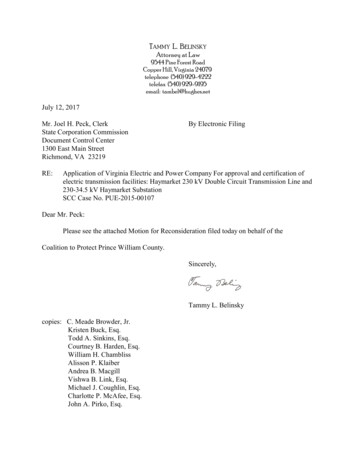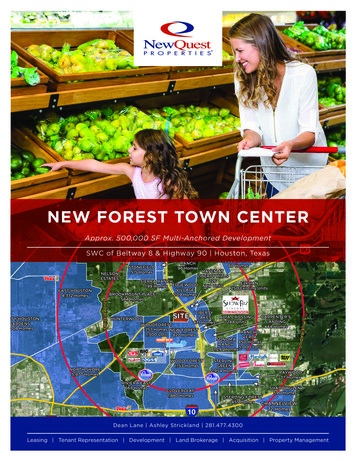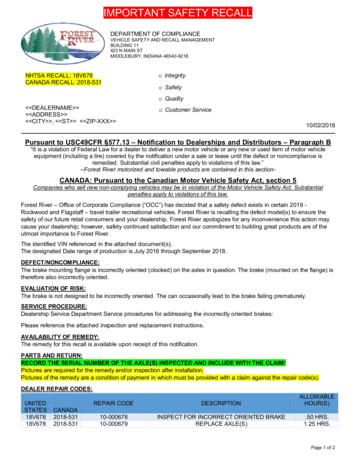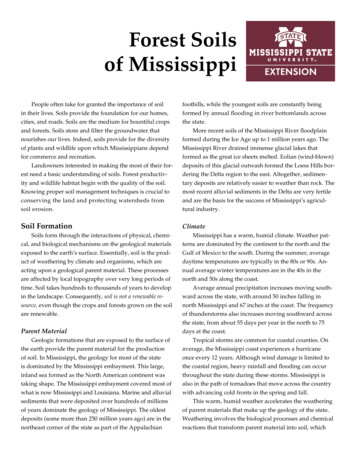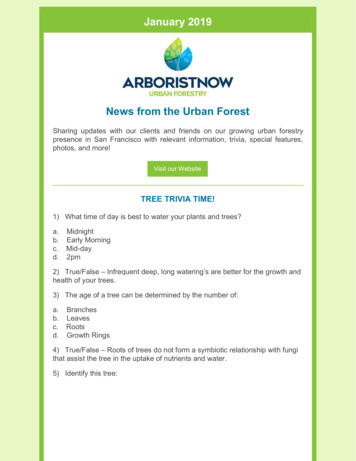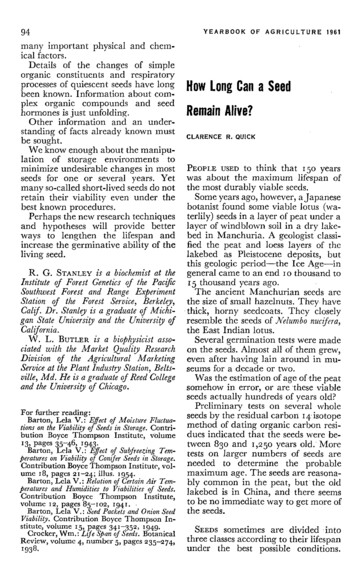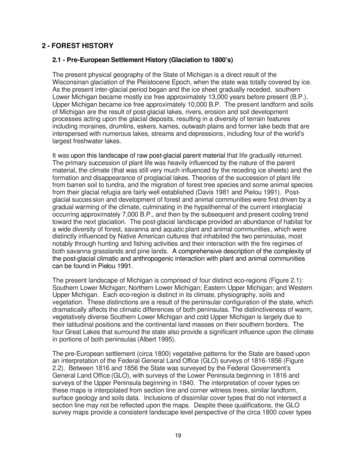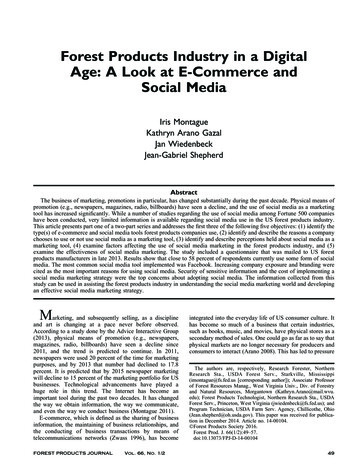
Transcription
Forest Products Industry in a DigitalAge: A Look at E-Commerce andSocial MediaIris MontagueKathryn Arano GazalJan WiedenbeckJean-Gabriel ShepherdAbstractThe business of marketing, promotions in particular, has changed substantially during the past decade. Physical means ofpromotion (e.g., newspapers, magazines, radio, billboards) have seen a decline, and the use of social media as a marketingtool has increased significantly. While a number of studies regarding the use of social media among Fortune 500 companieshave been conducted, very limited information is available regarding social media use in the US forest products industry.This article presents part one of a two-part series and addresses the first three of the following five objectives: (1) identify thetype(s) of e-commerce and social media tools forest products companies use, (2) identify and describe the reasons a companychooses to use or not use social media as a marketing tool, (3) identify and describe perceptions held about social media as amarketing tool, (4) examine factors affecting the use of social media marketing in the forest products industry, and (5)examine the effectiveness of social media marketing. The study included a questionnaire that was mailed to US forestproducts manufacturers in late 2013. Results show that close to 58 percent of respondents currently use some form of socialmedia. The most common social media tool implemented was Facebook. Increasing company exposure and branding werecited as the most important reasons for using social media. Security of sensitive information and the cost of implementing asocial media marketing strategy were the top concerns about adopting social media. The information collected from thisstudy can be used in assisting the forest products industry in understanding the social media marketing world and developingan effective social media marketing strategy.Marketing, and subsequently selling, as a disciplineand art is changing at a pace never before observed.According to a study done by the Advice Interactive Group(2013), physical means of promotion (e.g., newspapers,magazines, radio, billboards) have seen a decline since2011, and the trend is predicted to continue. In 2011,newspapers were used 20 percent of the time for marketingpurposes, and by 2013 that number had declined to 17.8percent. It is predicted that by 2015 newspaper marketingwill decline to 15 percent of the marketing portfolio for USbusinesses. Technological advancements have played ahuge role in this trend. The Internet has become animportant tool during the past two decades. It has changedthe way we obtain information, the way we communicate,and even the way we conduct business (Montague 2011).E-commerce, which is defined as the sharing of businessinformation, the maintaining of business relationships, andthe conducting of business transactions by means oftelecommunications networks (Zwass 1996), has becomeFOREST PRODUCTS JOURNALVol. 66, No. 1/2integrated into the everyday life of US consumer culture. Ithas become so much of a business that certain industries,such as books, music, and movies, have physical stores as asecondary method of sales. One could go as far as to say thatphysical markets are no longer necessary for producers andconsumers to interact (Arano 2008). This has led to pressureThe authors are, respectively, Research Forester, NorthernResearch Sta., USDA Forest Serv., Starkville, Mississippi(imontague@fs.fed.us [corresponding author]); Associate Professorof Forest Resources Manag., West Virginia Univ., Div. of Forestryand Natural Resources, Morgantown (Kathryn.Arano@mail.wvu.edu); Forest Products Technologist, Northern Research Sta., USDAForest Serv., Princeton, West Virginia (jwiedenbeck@fs.fed.us); andProgram Technician, USDA Farm Serv. Agency, Chillicothe, Ohio(Jean.shepherd@oh.usda.gov). This paper was received for publication in December 2014. Article no. 14-00104.ÓForest Products Society 2016.Forest Prod. J. 66(1/2):49–57.doi:10.13073/FPJ-D-14-0010449
for companies to merge their sales into the online world(Durfee and Chen 2002).Since the commercial introduction of the Internet, therehave been numerous studies that have examined informationtechnology (IT) and e-commerce adoption in the forestproducts industry. Vlosky and Gazo (1996) were among thefirst to look at IT interest in the forest products industry. Aseries of further studies by Vlosky et al. looked at ecommerce use in various sectors of the forest productsindustry (Vlosky and Westbrook 2002, Vlosky et al. 2002,Vlosky and Smith 2003). E-commerce adoption by theforest products industry in specific geographical regions alsohas been examined (Shook et al. 2002, Arano 2008,Montague and Wiedenbeck 2012). However, with theexception of the pulp and paper industry, research hasshown that IT adoption in forest products firms has beenbelow the manufacturing sector average (Hewitt et al.2011).The Internet, arguably the greatest communication toolever invented, has led to rapid change in the marketingenvironment with technology advances (Chase and Knebl2011). As a result, industries have had to transform howthey plan and implement their marketing messages to fit thegrowing demands of evolving communication technology(Grainger 2010).One of the most widespread contemporary marketingtools that has emerged as a result of the rise of the digitalmarket is social media. Social media–based exposuredepends on the strength of social networks. Boyd andEllison (2008) classify a social media network as a Webbased service site that allows individuals to (1) construct apublic or semipublic profile within a bounded system, (2)articulate a list of other users with whom they share aconnection, and (3) view and traverse their list ofconnections and those made by others within the system.Social media can help promote brands, drive more trafficto Web sites, and provide useful information to customers.The forest products industry has thrived on communicatingwith and strengthening bonds within a specifically definedcommunity (Koenig 2009). Facebook and Twitter, as well asother social media sites, provide businesses the mechanismneeded to further develop social relationships with theircustomers (Montague 2011). These close relationships wereharder to cultivate with multiple customers before theintroduction of the Internet and social media. There is anopportunity for the forest products industry to benefit fromthe enhanced relationships these tools create. With the fateof the proposed hardwood checkoff program (also known asthe commodity research and promotion program administered by the US Department of Agriculture [USDA])uncertain, the hardwood industry lacks a broad andcoordinated promotional campaign. For thousands of smallhardwood companies, social media marketing offers aheretofore absent opportunity to reach vast numbers ofcustomers and potential customers.The main goals of this study were to provide an up-todate overview of the use of e-commerce within the USforest products industry and to examine and describe theindustry’s use of social media as a marketing tool.Montague and Wiedenbeck (2012) conducted a preliminarystudy regarding social media use in the forest productsindustry using Internet data on forest products producersfrom two northern and two southern states. This projectextends the work of Montague and Wiedenbeck by looking50at social media use by the forest products industry across theUnited States. To fully understand how the Internet andsocial media are being used by the US forest productsindustry, this study will (1) identify the type(s) of ecommerce and social media tools forest products companiesuse, (2) identify and describe the reasons a companychooses to use or not use social media as a marketing tool,(3) identify and describe perceptions held about socialmedia as a marketing tool, (4) examine factors affecting theuse of social media marketing in the forest productsindustry, and (5) examine the effectiveness of social mediamarketing. This article is part one of a two-part series andwill address the first three objectives. Part two will addressfactors affecting social media adoption and social mediaeffectiveness.This research will be helpful to business managers whoare interested in a template to use to insert their companiesinto the world of social media marketing. In some cases thecompany may want to make the leap to Web-based businessin general. It also will provide a rudimentary map of thebenefits, concessions, and social media options open to acompany. This research will be beneficial to not only theforest products sector, but to any business looking to adoptsocial media as a new or larger component of theirmarketing mix.Materials and MethodsIn 2012, a preliminary study was conducted on Webstrategies used by forest products businesses in four easternstates (Montague and Wiedenbeck 2012). The informationobtained from this research was used as a guideline for abroader study that encompassed forest products businessesthroughout the United States.The study population consisted of primary and secondaryforest products companies in the United States. A randomsample of these companies was included in the survey. Atarget of 400 usable responses from both groups (primaryand secondary combined) was set to achieve a 5 percentsampling error at a 95 percent confidence level. A 30percent response rate was assumed, requiring at least 1,333companies to be included in the sample. However, toimprove the number of surveys returned, a total of 1,600surveys were mailed. A 2013 directory of forest productsmanufacturers under the Standard Industrial Classificationcodes that include lumber, furniture, and other forestproducts were obtained from Dun & Bradstreet, the world’sleading source of commercial information including databases for businesses.In 2013, a mail survey involving US forest productcompanies was produced and distributed by West VirginiaUniversity. The survey contained 29 questions and wasaccompanied by a cover letter explaining the survey.Questionnaires and data collectionThe data for this study were collected from a mail surveythat was conducted during May 2013.The Tailored Design Method of Dillman (2000) was usedin developing and administering the mail survey. Thequestionnaire included four sections pertaining to (1)company characteristics (nine questions), (2) e-commerce(four questions), (3) social media use (eight questions), and(4) social media effectiveness (eight questions). Participantswere given an opportunity to provide additional commentsMONTAGUE ET AL.
at the end of the questionnaire. Question types includedcategorical (multiple choice), rating (5-point scales), andopen ended. Three mailings were sent to sample companiesto ensure a high response rate. The initial mailings of thesurvey were sent in May 2013. A follow-up reminderpostcard was sent 2 weeks later, and finally another copy ofthe survey was sent 4 weeks after the initial survey.Of the 1,600 potential respondents, a total of 596 surveyswere returned owing to undeliverable addresses, refusals,and respondents who did not qualify. The total number ofusable responses was 166, which accounts for a 16.5 percentresponse rate.Data measures and analysisIn addition to answering questions referencing firmcharacteristics, respondents were asked to rate howimportant 12 factors were in determining whether to adopte-commerce using a 5-point scale anchored by 1 (notimportant) and 5 (very important). The responses for each ofthese 12 factors were submitted to a 1-sample t test todetermine which, if any, of the factors were considered to bemore or less important than the intermediate level ofimportance associated with a response of ‘‘3.’’ Pearsoncorrelation analysis was conducted to help evaluate thecorrelation between the more important factors as indicatedby the importance ratings assigned by respondents.Respondents also were asked to rank a list of nineconcerns that their company might have with adopting ecommerce on a 5-point scale anchored by 1 (not a concern)and 5 (major concern). The same scale was used to ranknine challenges companies might have using social media.To obtain a better understanding of social media usage,respondents were asked to indicate how often companysocial media accounts were updated on a 6-point scaleanchored by ‘‘never’’ and ‘‘hourly.’’ Last, respondents wereasked to rate their level of agreement with a predeterminedlist of 12 statements concerning social media as a marketingtool on a 5-point scale anchored by 1 (strongly disagree) and5 (strongly agree.) Simple descriptive statistics were used toevaluate responses to each question. We conducted t tests(1-sample; a ¼ 0.05) to determine those statements/factorsthat were overall judged to be significantly different fromthe neutral score of ‘‘3’’ in evaluating the responses to thesequestions.Assessment of potential nonresponse biasTo address the possibility of nonresponse bias, thedistribution of early respondents was compared with thedistribution of late respondents based on three variables(i.e., firm size, years in business, and net revenue) using theKolmogorov-Smirnov test (K-S test). The basic assumptionis that late respondents are a proxy for nonrespondents (Linand Schaeffer 1995). Results of the K-S tests indicate thatthe distribution of the early respondents with respect to firmsize (K-S statistic ¼ 0.16), years in business (K-S statistic ¼0.04), and net revenue (K-S statistic ¼ 0.15) was notstatistically different from that of the late respondents.Results and DiscussionFirm characteristicsEach respondent was asked to provide key demographiccharacteristics for their company. This included informationon the manufacturer’s location, products made, sales, andFOREST PRODUCTS JOURNALVol. 66, No. 1/2number of employees. The information provided onemployees was then used to group companies into small(1 to 19 employees), medium (20 to 99 employees), andlarge (100 or more empl
articulate a list of other users with whom they share a connection, and (3) view and traverse their list of connections and those made by others within the system. Social media can help promote brands, drive more traffic to Web sites, and provide useful information to customers. The forest products industry has thrived on communicating

